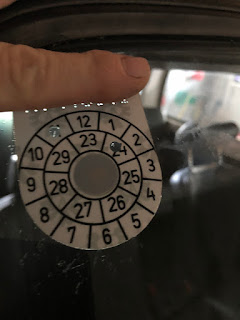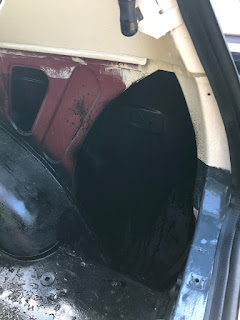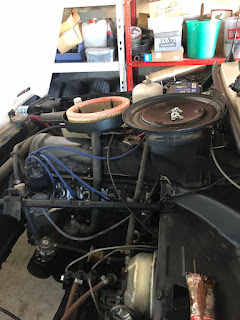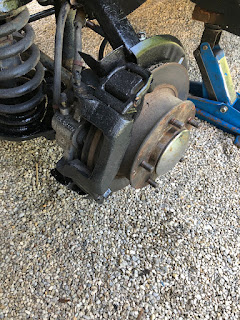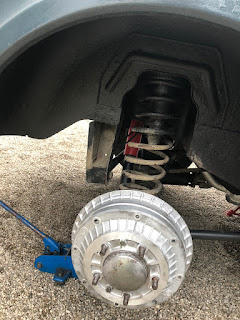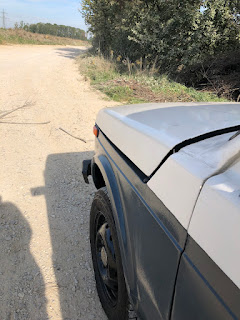As I pointed out a year ago, in my first post on Martha II, whilst bearing a very German name (Matra standing for Marx & Traub), is actually either "heavily influenced" or a more or less licensed copy of a LeBlonde Regal 10inch/12inch. So why would such a reputable German manufacturer choose a US design, which has a strong emphasis on cutting all sorts of imperial threads? The answer lies in the very first customer. The newly founded German Bundeswehr was well equipped with a plethora of US-made tanks, which quite obviously, were equipped with pretty every imaginable thread, but metric. As they also were rather worn, mobile tank repair units were formed and these were equipped with exactly these Matra MDR2A lathes.
To make these lathes substantially more useful for use in a metric country, one of the oldest engineering tricks in the book was employed: slap on a 127 tooth wheel and see how you can turn that 8TPI leadscrew into something that can at least produce some vaguely useful metric threads. Unfortunately going down the metric route means that the Norton-box on the front can't be used. Still, in the end a very useful spread from 0.5mm to 7.5mm thread pitches can be created. (Special honorable mentions for 0.50, 0.75, 1.00, 1.25, 1.50, 1.75 and 2.0 pitches spanning pretty much everything one can find on regular and fine thread pitch metric bolts in typical machinery applications.) With that incentive in mind, I set out to make the metric feeds work again.
A quick rummage through the boxes of small bits (and some large bits), revealed that the axles for the metric gear scissor were absent, one of the stub-axles on the tumbler reverse lacked a means of retention and the plunger of the selector was broken as well and a few small bits like missing shaft keys and the like.
I started with the shaft keys, because I had to start somewhere anyway, it was Sunday and I had some stock in the form of a bit of angle iron available.
In reality it would have been a pretty standard 5x4x25mm shaft key, as is available form any bearing store, which I suspect was part of making this machine somewhat metric, just like the spindle nose which sports a very typical (for the time) Din800 M33 spindle nose (M33x3.5mm).
As I had no drawings of what the original axles would have looked like, I sort of had to wing it and design them from scratch, with the only real limitations being that the slot in the scissor was around 15mm wide and the milled out groove on the back around 23mm, which made M14 a sort of logical choice. As all the other gears where held on with M12 nuts that was sort of a given as well.
One of the things I absolutely wanted was to have a way to lube the gears
internally, so the axle shafts were drilled out and had an oil-groove cut in.
One thing I had sort of missed was that the step in the rear was maybe good
enough to locate and space out the gear on the axle, but it was definitely not
good enough to positively locate it on the scissor. Then again as nothing on
such a lathe is allowed to only serve one purpose, I chose some M16 nuts (the
axle diameter is 17mm). Step one was to part off the M16 nut to the correct
width.
Put it back in the chuck and use that same bit of M16 all-thread to align it
properly and then bore it out to a nice press-fit on the shaft.
Which was quite literally a case of *tap-tap*. (And then tig-weld them in
place, just to be sure.)
Getting the whole lot set up, requires roughly 3.5 hands, but once you figured out it goes: lower gear on the scissor, top gear-set on the scissor and then tighten the scissor once it is engaged, it is actually manageable.
Now the geared head on the Matra isn't exactly quiet to start with, but the video only vaguely gives you an idea of the amount of noise that is generated by the whole gear train.
When trying to switch the tumbler around and into reverse I realised two things: The reverse gear only had stayed in place so far because it wanted to and the locating pin on the plunger was missing.
I decided against fabricating this stub-axle from scratch as it turned out not
to be hardened and the only trick bit in making it work was how to hold it in
the chuck to drill and tap it for M8.
A bit of M8 allthread loctite'ed into the stub axle and it was good to go again.
Which left *just* the plunger to get fixed and have everything working again. Except there was nothing *just* in this process as it took way longer than it even remotely should have.
After some casual inspection it became apparent that fixing the old plunger
rod was not going to happen, so I made a fresh one from 10mm silver steel.
Except there were two other ones I made. One on which I ignored the fact that
whilst it was an M8 bolt, it had a 7mm shank (no idea why) and the other one,
also from silver steel, when finishing the cross slide was sucked in and this
elegantly removed the whole thicker section.
The plunger testfitted without a spring.
And lastly two glamour shots - finally with the metal enclosure for the change
gears reinstalled and rather unusual for me, with the chip tray somewhat
cleaned from the majority of the chips.























